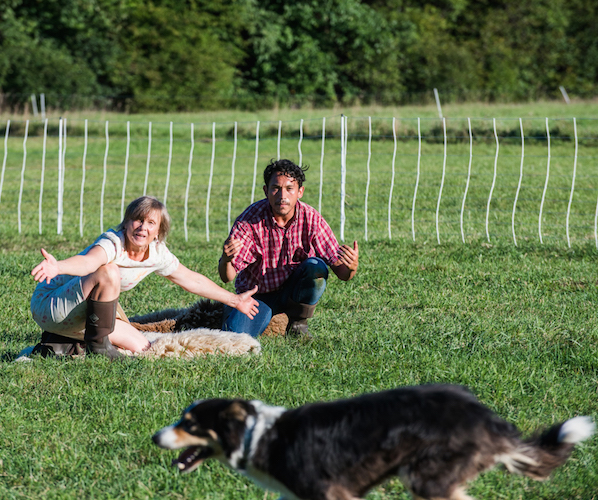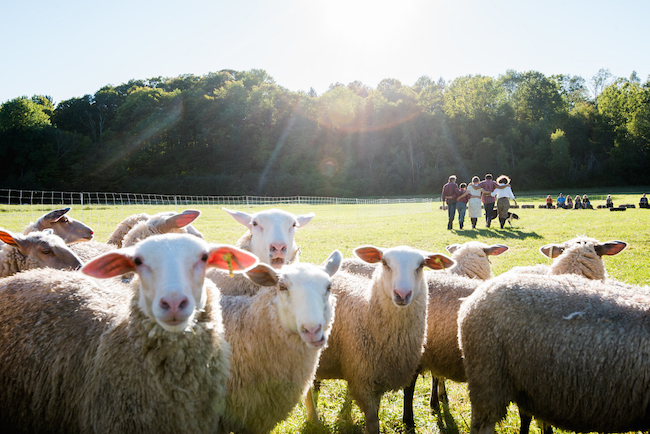Theater Feature: “The Rest is Silence” — A “Doggie Hamlet”
A difficult balancing act: marrying art with the community-based traditions of everyday rural life.
Doggie Hamlet by Ann Carlson. At Hopkins Center for the Arts, Dartmouth Green, Dartmouth College, New Hampshire, June 29 at 4:30 and 7 p.m. Free, no tickets required.

An action scene in “Doggie Hamlet.” Photo: Kelly Fletcher.
by Susan B. Apel
Choreographer, dancer, and internationally renowned performance artist Ann Carlson has a history of grasping mundane human gestures and turning them into spectacle. And given her iconoclastic past, it is no surprise that her upcoming creation—Doggie Hamlet—has expanded her reach to include the movements of herding dogs and sheep. The animals are the stars — the principal performers of this live-action, pastoral dance. Described as “a meditative, largely wordless spectacle,” Doggie Hamlet is an amalgam of dance, theater, and the fine art of sheepherding. Carlson calls it “a ceremony, but not quite.”
The outdoor setting is part of the aesthetic experience. Is this theater that would resonate in New York City (where it may eventually appear)? Who knows? Its appeal here is obvious — the performance is rooted in the cultural vernacular of New England. Margaret Lawrence, Hopkins Center Programming Director, views Doggie Hamlet as “a chance to celebrate dance, the Upper Valley’s agricultural legacy, a deep commitment to sustainability, and best of all, the quintessentially New England concept of a true ‘common’: a shared space … where everyone is welcome.”
Doggie Hamlet was inspired by the Shakespearean tragedy and David Wroblewksi’s 2008 novel The Story of Edgar Sawtelle, a tale of a mute boy who tries to avenge his father’s death on the family’s dog breeding farm. Carlson’s piece has garnered praise during its development process for its originality. (The Hopkins Center presentation will be its world premiere.) But there have been negative reactions as well. Laughter is one. During her four years of working on it, Carlson says she always saw the piece as having “gravitas”; she was initially annoyed when people, upon hearing about the set-up of the show, couldn’t help but titter. She eventually realized that the laughter was a sign of discomfort, their questioning “where to put something” that was unfamiliar and difficult to categorize.
The title itself is amusing. Carlson explained that she was in a discussion with her friend, author Geraldine Brooks, about The Story of Edgar Sawtelle. Brooks described the Sawtelle narrative as a “Doggie Hamlet.” (Brooks, by the way, was not alone in seeing Shakespearean resonances in the Sawtelle novel — so did a number of the book’s reviewers.) As Carlson was developing the performance piece, she used it as a working title. And it stuck.
Doggie Hamlet has also been greeted with ridicule, voiced in the tired “But is it art? question posed by Elizabeth Harrington in her recent article (headlined ‘Taxpayers Foot Bill for “Doggie Hamlet”’) in the Washington Free Beacon. She called it “conceptual art” in demeaning quotation marks. Harrington based her judgment on a short video of a trial performance, describing what she saw as “actors yelling and running at sheep in a field in Vermont.”
Gia Kourlas, dance critic for the New York Times took on Harrington’s assessment. Granted, she argued, “At first glance, it doesn’t seem like a performance. The stage is a meadow, and the score is a collection of sounds, including the commands of a dog handler and the pounding of hooves.” Kourlas notes that Carlson’s work lacks any offensive elements, unlike Serrano’s Piss Christ and Robert Mapplethorpe’s erotic photographs, which were famously denounced by conservatives and deemed unworthy of NEA funding decades ago. (In fact, Carlson herself did not directly receive any NEA funds for creating this work. The Hopkins Center has received modest support from the NEA for presenting Doggie Hamlet, as well as monies from other arts organizations that are privately and federally funded.) Kourlas goes on to praise Carlson’s work; she makes a plea for patience, suggesting that critics wait for a staging of the complete work. Understanding novel performance ideas demands being fair.
When asked about the “Is it art?” controversy, Carlson insisted that Doggie Hamlet be seen in context. It is a work that has been several years in the making. Because it is not linear nor straightforward, it is, like much performance art in Carlson’s words, “an easy target.” The use of animals as performers (best known in circus acts) make Doggie Hamlet fodder for easy fun. Carlson believes the work is serious, that it intertwines — and shows deep respect for — two very ancient and disparate cultural practices, dance and sheepherding.

To baa or not to baa? A scene from “Doggie Hamlet.” Photo: Kelly Fletcher.
Familiarity with some of Carlson’s past work would make Doggie Hamlet less perplexing. Carlson is known for grounding her choreography in everyday reality; the first stage of her process is to observe people engaged in their ordinary activities. In a previous work for the Hopkins Center, she embedded herself with the custodial staff of Dartmouth College; she closely inspected the physicality of their work. An early and well-known piece, Sloss, Kerr, Rosenberg & Moore, stemmed from her watching male (it was the 1980s) lawyers on their way to work in Wall Street firms. In both cases, Carlson did not just appropriate her subjects’ movements, stylize them, and give them to trained dancers to perform. She cast the custodial staff and the attorneys as performers on stage. Doggie Hamlet follows her reality-based approach to the letter — the movements of sheepherders and sheep are best communicated by the animals themselves.
To help provide context for the show, the Hopkins Center is hosting several auxiliary activities in the week leading up to the world premiere. These events include a dance class with the performer, a book discussion of The Story of Edgar Sawtelle, demonstrations by local sheep farms, and a screening of the 2015 film Rams, which is about aging Icelandic sheep farmers.
Mary Lou Aleskie, the Hopkins Center’s new director, is proud to be presenting Carlson’s newest creation. She sees Doggie Hamlet as conceptual art — without the dismissive quotation marks. She considers the performance piece to be very much “in keeping with the groundbreaking, remarkable work” that has come to the Hopkins Center. Above all, she joins others who appreciate Carlson’s attempt to pull off a difficult balancing act: marrying art with the community-based traditions of everyday rural life.
Susan B. Apel is a writer and law professor whose creative nonfiction and poetry has appeared in Vine Leaves Literary Journal, Best of Vine Leaves 2015, Rhizomes, The Vignette Review, Woven Tale Press, Bloodroot, and the Fredericksburg Literary and Art Review. Her blog, ArtfulEdge, in which she writes about arts in the Upper Connecticut River Valley, appears regularly on the dailyUV.com. She is also a contributor to the newspaper, Vermont Woman. She lives in Lebanon, NH.
Tagged: Ann Carlson, Dartmouth College, Dartmouth Green, Doggie Hamlet, Hopkins Center for the Arts, sheepherding
